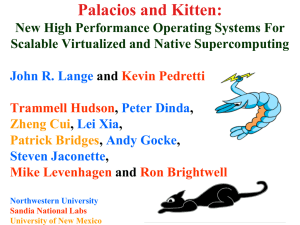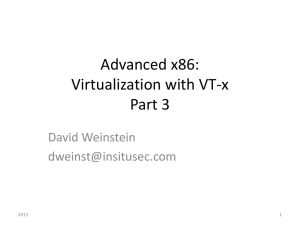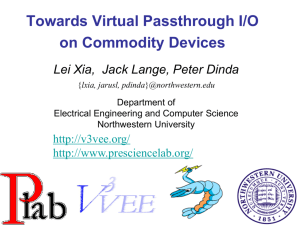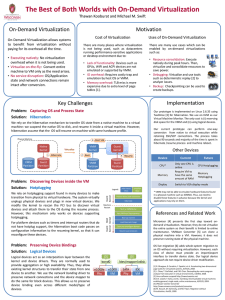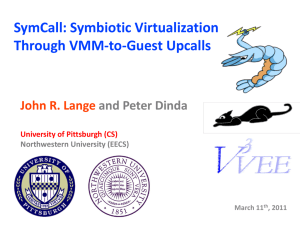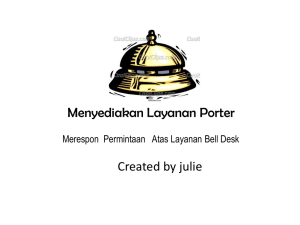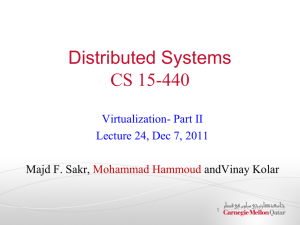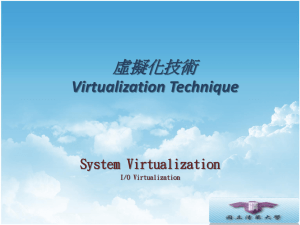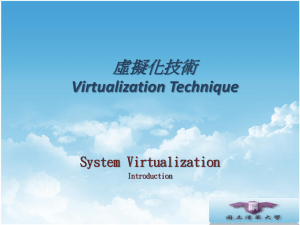vee11-hpc - The Prognostic Lab
advertisement
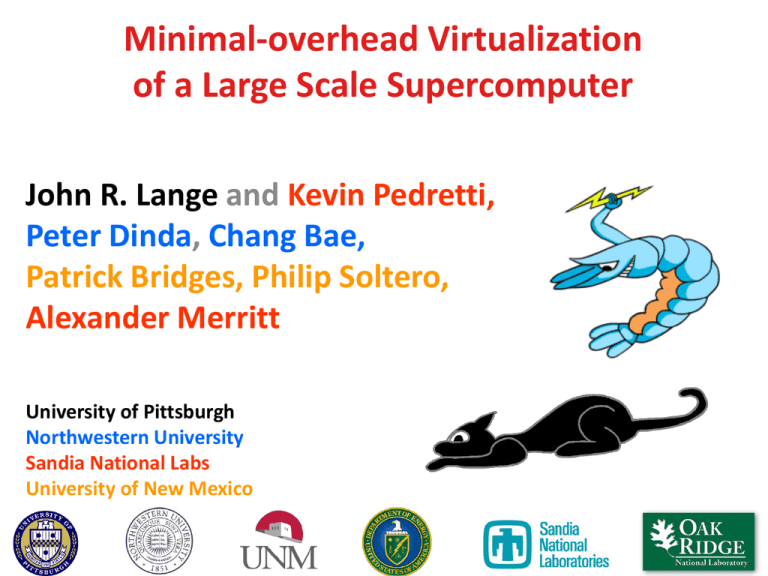
Minimal-overhead Virtualization
of a Large Scale Supercomputer
John R. Lange and Kevin Pedretti,
Peter Dinda, Chang Bae,
Patrick Bridges, Philip Soltero,
Alexander Merritt
University of Pittsburgh
Northwestern University
Sandia National Labs
University of New Mexico
Summary
• Palacios
– First VMM for scalable HPC
– Open Source and available
• Kitten
– First open source Lightweight Kernel for High Performance
Computing (HPC)
– Open Source and available
•
Palacios: A New Open Source Virtual Machine Monitor for Scalable High
Performance Computing, Lange, et al (IPDPS 2010)
• HPC virtualization at scale
– Performance within 3% of native
– Large scale study of virtualization (4096 nodes)
2
Outline
• Palacios and Kitten
– VMM/OS for HPC virtualization
• Large scale test
– Parallel apps running on supercomputer
• Minimal overhead techniques
– Passthrough I/O
– Virtual Paging
– Controlled Preemption
Virtualization in HPC
• Virtualization benefits applied to HPC
– Fault tolerance
– Broader usage for legacy applications
– Testbeds for future exascale systems
• DOE X-Stack project to deploy virtualization on
future exascale systems
– UNM, NWU, Pitt, SNL, ORNL
• Only if it doesn’t degrade performance…
– Tightly coupled parallel applications
– petascale and soon exascale
4
Palacios VMM
• OS-independent embeddable virtual machine monitor
• Open source and freely available
• Virtualization layer for Kitten
– Lightweight supercomputing OS from Sandia National Labs
• Successfully used on supercomputers, clusters (Infiniband and
Ethernet), and servers
http://www.v3vee.org/palacios
5
Kitten: An Open Source LWK
• Better match for user expectations
– Provides mostly Linux-compatible user environment
• Including threading
– Supports unmodified compiler toolchains and ELF executables
• Better match vendor expectations
– Modern code-base with familiar Linux-like organization
• Drop-in compatible with Linux
– Infiniband support
http://code.google.com/p/kitten/
6
HPC Performance Evaluation
• Virtualization is useful for HPC, but…
Only if it doesn’t hurt performance
• Virtualized RedStorm with Palacios
– Evaluated with Sandia’s system evaluation
benchmarks
Cray XT3
38208 cores
~3500 sq ft
2.5 MegaWatts
$90 million
7
Scalability at Large Scale (Weak Scaling)
Catamount Guest OS
Within 3%
Scalable
CTH: multi-material, large deformation, strong shockwave simulation
8
Minimal Overhead Virtualization
• Passthrough I/O
– Direct I/O access with no virtualization overheads
• Optimized virtual paging
– Nested and shadow paging optimizations
• Controlled Preemption
– Host OS noise minimization
– Characterizing application sensitivity to OS interference using kernellevel noise injection, Ferreira, et al (Supercomputing 2008)
Passthrough I/O
• I/O virtualization significantly degrades
performance
• Mitigated by hardware support
– SRIOV/IOMMUs
• In HPC we can do better
– Passthrough I/O without any translation overhead
Passthrough I/O architecture
Guest Offset
Guest Memory
Host Memory
PCI
DEV
DMA_Address = Guest_DMA_Address + Guest_Offset
if (DMA_Address > (guest_memory_size + Guest_Offset)) {
//error
}
Trust
• HPC environments run trusted software stacks
– Can rely on guest/VMM cooperation
• Guest directly controls DMA operations
– But sets DMA addresses cooperatively with VMM
– The VMM trusts the guest to do DMA correctly
• DMA address calculations are centralized in
guest OS
– Linux DMA modifications: 20 lines of code
Infiniband on Commodity Linux
(Linux guest on IB cluster)
2 node Infiniband Ping Pong bandwidth measurement
13
Interrupt Overheads
Interrupt Driven
Polling
MPI Ping-Pong Latency
Virtualized Paging
Shadow Paging
Compute Node Linux
HPCCG: conjugant gradient solver
Catamount
Lange, et al (IPDPS 2010)
15
Virtual Paging mechanisms
Nested Paging
Shadow Paging
• No paging exits
• More TLB misses
• More paging exits
• Better TLB behavior
• Good:
• Good
– Concentrated access
patterns
• Bad
– Random access patterns
– Infrequent page table
modifications
• Bad
– Frequent context switches
Improving Nested Paging
• Palacios + Kitten makes large pages trivial
• Palacios preallocates guest in contiguous host
memory
– Kitten ensures large page alignment
Stream
Random Access
Selective Virtual Paging
• Nested paging does better…
– But shadow paging still performs better with 4KB
guest pages
• Still need to selectively choose paging approach
Stream
Random Access
Controlled Preemption
• OS noise generates a large performance penalty at
scale
– Timers, competing kernel threads, etc
– 2.5% overhead leads to order of magnitude application
performance drop
• Ferreira et al, Supercomputing, 2008
• Palacios/Kitten allow per guest control over scheduling
– VM only yields when appropriate
• 10x reduction in host overhead compared to minimal
configuration of KVM/Linux
Summary
• Virtualization can scale
– Near native performance for optimized VMM/guest
• VMM and guests need to cooperate
– Bidirectional information sharing is necessary
• Symbiotic Virtualization
– A virtual machine interface designed for guest/VMM cooperation
– 2 components
• Guest OS provides internal state to VMM
• Guest OS services requests from VMM
– Interfaces are optional
Conclusion
Palacios:
http://www.v3vee.org/palacios
Kitten:
http://code.google.com/p/kitten/
V3VEE Project:
http://www.v3vee.org
Symbiotic Virtualization in HPC
• HPC environments are well suited to symbiotic
techniques
• Full trust of the software stack
– Fewer security concerns
• Specific hardware configurations
– Limited number of devices
• Environments are much smaller
– Internal OS state is simpler than a general purpose OS
• At large scale performance impact is dramatic
– Large impetus to optimize VMM and OS
22
Summary
• Virtualization can scale
– Near native performance for optimized VMM/guest
• VMM needs to know about guest internals
– Should modify behavior for each guest environment
– Example: Paging method to use depends on guest
• Black Box inference is not desirable in HPC environment
– Unacceptable performance overhead
– Convergence time
– Mistakes have large consequences
• Need guest cooperation
– Guest and VMM relationship should be symbiotic
23
Summary
• Black Box inference is not desirable in HPC environment
– Unacceptable performance overhead
– Convergence time
– Mistakes have large consequences
• Need guest cooperation
– Guest and VMM relationship should be symbiotic
24
